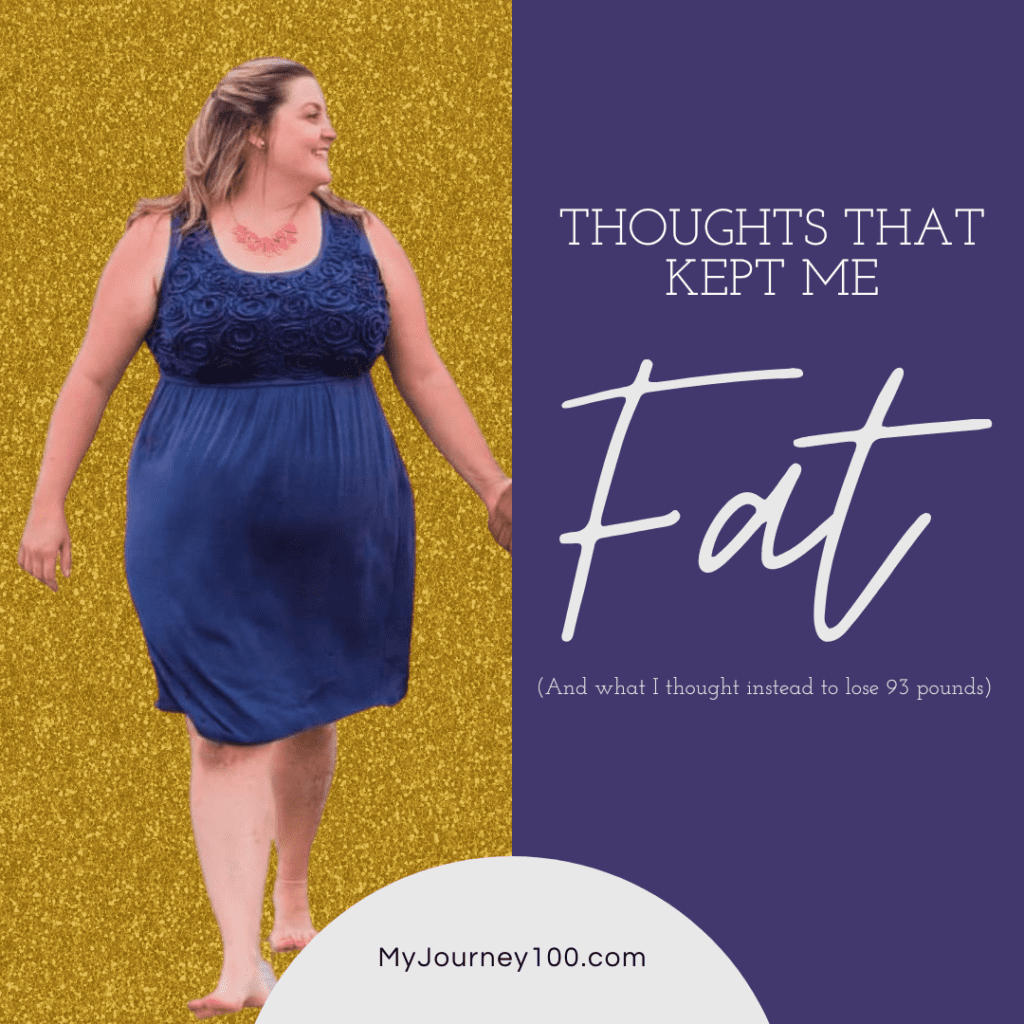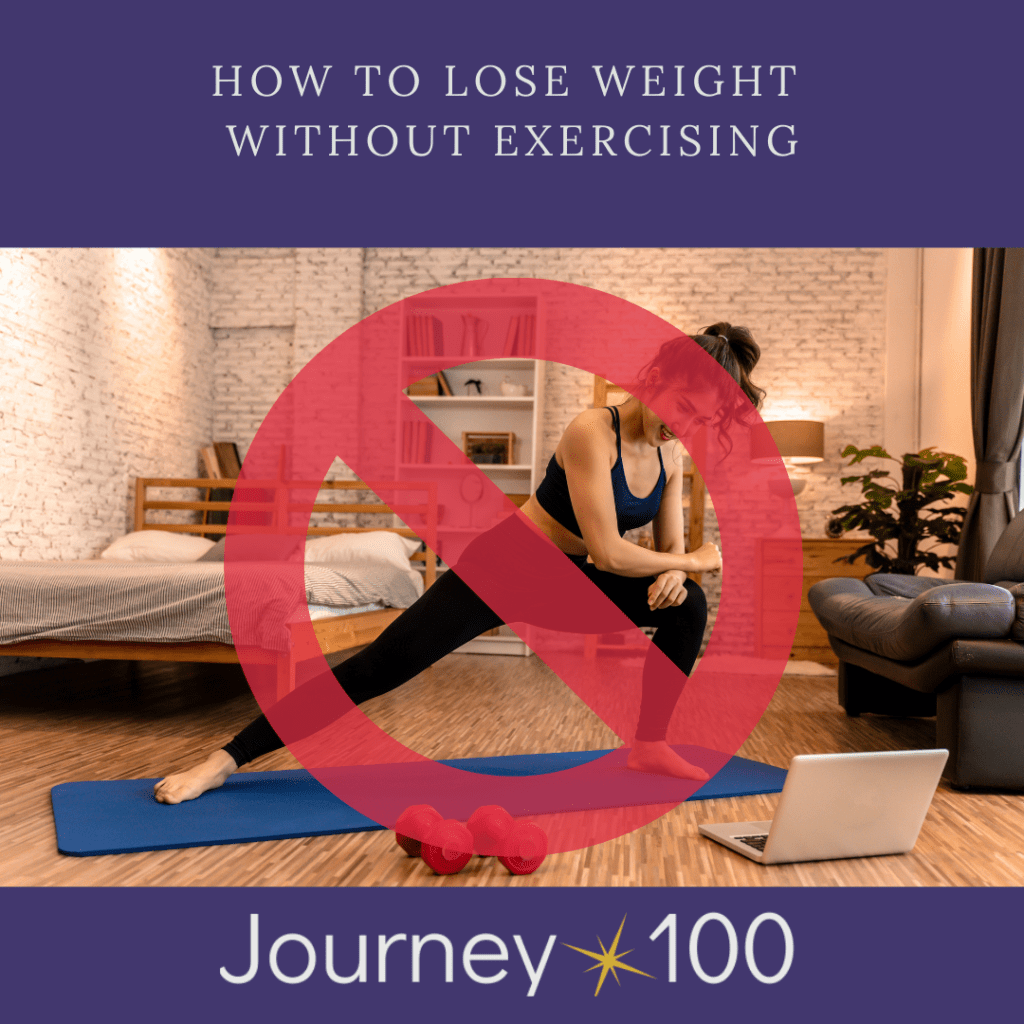Five thoughts that kept me FAT

For all of my adult life, I felt stuck. It felt like my fate in life was to be overweight. I tried and failed so many diets that I figured I was just broken. In reality, the only thing that was broken was my thinking. Here are five thoughts that kept me FAT: I don’t feel like it This thought kept me waiting for the motivation fairy to drop in and fill me with motivation to do the things I didn’t feel like doing. In reality, feeling like doing something is never a requirement. We do so many things in our every day lives that we probably don’t feel like doing. For instance: paying bills, changing dirty diapers, following speed limits, chores around the house, attending meaningless work meetings, etc. You don’t feel like doing them but you get it done anyway. The motivation to do something doesn’t come from an outside source. Motivation is created by you. If you are still waiting around for motivation to strike, check out this blog post on “How to find your weight loss motivation in 3 easy steps.” Quit using “I don’t feel like it” as an excuse to remain the same. Instead tell yourself “I don’t have to feel like it to do what’s best for myself.” I deserve to eat whatever I want This kept me feeling entitled to eat indulgent foods all day, every day. ALL the diets I had been on before left me feeling restricted and deprived. And I hated it! I didn’t want to feel that way so I told myself “I deserve to eat whatever I want.” But the truth of the matter is I always have a choice in what I eat. Whether I am on a restrictive diet or eating everything in sight, it is because I am choosing to do so. Continuously telling myself that I deserved to eat whatever I wanted also left me feeling entitled to a party in my mouth each time I ate. I only thought about amazing and entertaining foods I wanted to eat. Foods that nourish my body and help it perform at its best were rarely considered. Once I changed by thought from “I deserve to eat whatever I want” to “I can eat whatever I want however I choose to eat healthier so I can achieve my health goals,” I finally found a balance between nourishing my body, eating foods that were entertaining AND losing weight. I don’t have any willpower Another thought that kept me fat. It reinforced that I was broken and there was no hope for change. The reality of willpower is that everyone has it. Some people use their willpower each day and therefore it’s stronger. Others have let it wither away like an atrophied muscle. If you want more willpower, then you have to start using it. Start small. Try leaving one bite behind after each meal. When that starts feeling easy, leave two or opt for half a plate of veggies. These small moments will help strengthen your willpower. The stronger it gets the more you are able to use it throughout your life. A great thought to think instead of “I don’t have any willpower” is “Willpower is a muscle that everyone has and I am working on making mine stronger each day.” I don’t want to miss out on life Oh man. This was a big one. It kept me believing the lie the food is the only source of connection and fun in life. Spoiler: it’s not. In fact, food can often be a distraction to true connection and fun. Food is an activity that many people enjoy doing together however it isn’t a requirement. I am not missing out on life if I choose not to eat or choose to eat differently than people around me. Instead, think of all the ways that being healthier allows you to enjoy your life MORE. This was a game changer for me. I had never considered that my life could actually be better and I could be more engaged if I was losing weight and getting healthier. I could be more intentional in my conversations and interactions with others at parties. I could run and play with my sons. Bucket list items I was sure I could never do become possibilities again….hello standup paddle boarding, indoor skydiving and boudoir photoshoot! Not to mention that getting healthier also means living longer. And not just living longer to be bedridden but living longer with a functioning body. Try thinking “Being overweight taxes my body and shortens my lifespan which truly results in missing out on life.” I’ve failed too many times before. By the time I reached 250 pounds, I had tried and failed at least a dozen diets. I felt like there was nothing left to try that would work for me. I felt so hopeless. Thinking “I’ve failed too many times before” was simply an excuse to stop trying at all. This thought kept me fat because it reminded me how much failure sucked before. It was my way of protecting myself from future pain and humiliation of failing yet another diet. However failure is a natural part of the human experience. If we all stopped doing anything the moment we failed, then none of us would learn to walk. The first time we fell down, we would stay on the ground. But for some reason failing a diet (or multiple ones), seems like a real reason to never try to get healthier again. Maybe I just found dozens of ways that didn’t work for me and that’s OK. That’s actually perfect! Every way that doesn’t work is actually a step closer to finding what DOES work. So instead of the thought “I’ve failed too many times before” that kept me fat, I chose to think “I want to figure out how to live my healthiest life on MY terms.” You can figure out weight loss on
How visualization can help you lose weight

A powerful tool you can use on your weight loss journey is visualization. I often tell my clients that our thoughts are the instruction manuals for our brains but that doesn’t just include the sentences we tell ourselves. Our brains are powerful machines. You can reinforce those thoughts, create more desire, strengthen commitment and increase motivation by using visualization. Here is how visualization can help you lose weight: Instructions for your brain First, visualization is a process of seeing images in your mind. If you think about a tree, chances are you are able to visualize a tree in your mind. Words when paired with visual images tell a complete story. Your brain has a complete story of what you want on your weight loss journey when you pair your thoughts along with visual images. When your brain clearly understands the goal, it is free to start going after the solution and paving a way to achieve that goal. If you are unsure of where to begin with visualization of your weight loss goal, start with visualizing yourself looking into a mirror. Visualize how your stomach is smaller, your legs slimmer and maybe your cheeks less round. You can envision yourself in smaller clothes or maybe even visualize your current clothing fitting looser on your smaller-sized body. For more advanced visualization, envision yourself going throughout your day. How do you get out of bed? How do you go down the stairs? What does it look like getting in and out of your car? Envision yourself going through these daily activities in your slimmer body. Create desire Visualization also helps create desire on your weight loss journey. Many of my clients blame their reason why for not being compelling enough and why they choose to quit. More often it is because they have not spent enough time thinking about their why and creating a strong relationship with it. The more you think about the reason why you want to lose weight, the more important and desirable it becomes to you. Thinking about your reason only on January 1st is a recipe for remaining the same. But if you think about your reason every single day of the month for an entire year, you’ll build desire and commitment to that goal. Another great way to build that desire for your weight loss goal is to visualize yourself at your goal weight daily. Envision yourself enjoying your new slimmer body. Think of the different activities you’ll engage in, that your weight currently holds you back. Visualize yourself in clothes that you love and feeling confident in them. Create a vision in your mind of yourself that you truly want and are excited to experience. Find solutions to obstacles You can also use visualization as role play for situations you find tough to deal with in real life. Let’s say that you struggle with leaving restaurants overly stuffed. Visualization can be an amazing tool to walk through going to the restaurant and taking a to-go box home with half of your meal inside. It’s a lot easier to visualize that action in your mind when the delicious food isn’t sitting in front of you. Again, the visualization becomes the instruction manual for real life. Once you get comfortable packing up half of the meal into the to-go container in your mind, you can do it more easily in real life because your brain already knows the clear instructions on how to do it. Help keep yourself going Motivation can come and go on your weight loss journey and that’s totally normal. Sometimes getting your shoes on is the hardest part of the workout. Visualizing yourself putting on the shoes, completing the workout and seeing yourself be proud of that accomplishment can be a great way to get yourself motivated to take that positive action again. Not only that but visualizing yourself at your goal weight helps remind yourself of what today’s action can result in. If you are lacking in motivation, you can return to feeling motivated by visualizing a time when you felt really motivated. Picture where you were, what you were doing and how the feeling of motivation felt in your body. Of course, along with that visualization, tap into the thoughts you were telling yourself at that time so you have a really clear picture of that motivation. Together these two things are a great way to return to that motivated state and keep yourself going on your weight loss journey. Have you tried visualizing yourself at your weight loss goal? Comment below. Your Coach, Andrea
How to lose weight without exercising

Weight loss is taught as math. It’s calories in minus calories out. If you get a negative number, you will lose weight. The best way for many of us to lose weight is to eat less and move our body more. But does it have to be that way? Do you have to exercise? For those of you who don’t like to exercise, this post will help you lose weight without it. Here are three ways without exercise to lose weight: 1. Listen to your body Our bodies are magnificent machines. They communicate with us how much food we need to stay healthy and trim. In our world of super palatable and nutritionally-lacking foods, it has become easy for us to lose touch with our body’s signals of hunger and satisfaction. At my high weight of 250 pounds, I was completely detached from the feeling hunger. I was eating all the time just because it was “meal time” or someone simply suggested a food that sounded good. The first 30-ish pounds came off just by listening to the signals from my body again. I use a hunger scale rating to quantify different levels of hunger and satisfied. It’s helpful in differentiating mild hunger from famished or satisfied from overly full. Check out this blog post on getting in tune with your hunger signals for more information. The best way really hear what your body is telling you is to check in often and notice the different sensations you feel. Be curious and patient as you learn this new skill. Before you eat, ask yourself: How do I know I’m hungry? Where do I feel the hunger in my body? Could what I am feeling be something other than hunger? After you eat you can ask yourself some similar questions: How do I know that I have had enough to eat? What does satisfied feel like in my body? What activities could I engage in right now and feel good doing? Here’s a hint for that last question: If you feel like the only thing you could do is unbutton your pants and lie down on the couch, you have really flown past your body’s satisfied cues and are officially stuffed! 2. Solve for the non-hunger reasons you are eating Many Americans are overweight simply because they are eating for reasons other than hunger. Many of us are familiar with emotional eating as eating when we are sad or depressed. But there other times that we emotionally eat that are a little more subtle. At the beginning of the COVID pandemic and teleworking 100% from home, I noticed something interesting about my work day: I was constantly thinking I needed a snack! When I worked in the office, it was very easy to pack my snacks and eat only during my break times. At home, the kitchen was a mere 20ft away and my brain continuously told me I should go check what was in the pantry. After getting curious with myself, I realized that I was constantly feeling overwhelmed with having the kids home with me, unsure of how to manage my team virtually and uncertain how we were going to stay healthy and well. It’s not pleasant feeling overwhelmed, unsure and uncertain. Our brains seek pleasure and want to avoid pain. So my brain was doing what it does best offering me a way to feel pleasure: FOOD. Once I realized this I could solve for the real problem. I made a plan to create boundaries for me and my kids during the workdays and gave myself regular breaks away from everybody. I also let myself know that feeling uncertain and unsure was very normal. Just acknowledging how I felt and realizing it is normal to feel that way was immensely helpful in allowing those emotions to process and pass. Another example that comes up for many of my clients is using food as relaxation. The unfortunate part is that when you are eating the food, you may tell yourself that you feel relaxed but often once the chips or cookies are gone, the shame and remorse set in. Often the brain goes crazy with thoughts of self judgement that stress you out and leave you constantly wondering if you will ever be able to lose your weight or if you are doomed to a life of obesity. Then you are stressed all over again and needing to relax. Thus the cycle begins again. Solving for what you are truly needing in those moments is so key to avoid eating when you aren’t hungry. Here are some questions to help identify if you are eating for a non-hunger reason: Do I have physical hunger sensations right now? If I couldn’t eat right now, what else would I be doing? If I couldn’t eat right now, what would my brain be thinking? What am I truly hungry for? Finally, true hunger is a gradual process. Your body will start sending gentle signs that you are hungry at first. The hunger signals gently come and go. As time passes, the signals get louder and more evident. If you feel like hunger came out of no where and feels really urgent, it’s time to check in with yourself emotionally and see what’s really going on. 3. Stop cleaning your plate The final tip for losing weight without exercise is to eat a little less. You don’t have to cut what you are eating by drastic proportions. Just leave a few bites behind. Not eating a couple bites at each meal might seem small and insignificant but I promise you, they will add up quickly! I don’t encourage counting calories but to illustrate the point let’s count them. If we say each bite is 50 calories and you leave two bites behind at each meal that is 100 calories a meal and 300 calories a
